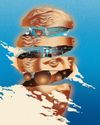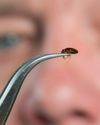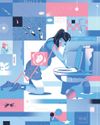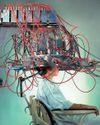
If you've made a resolution around changing your appearance, you're not alone. Around 43% of adults in the UK set a goal to lose weight last year. For many, these aims may also extend to more extreme methods of appearance alteration, such as cosmetic procedures or plastic surgeries.
But when does this common, widespread desire for self-improvement or enhancement become something more sinister? For around 3% of the general population, the drive to fix or change one's physical appearance becomes a constant - a condition known as body dysmorphic disorder (BDD).
Individuals with BDD see themselves as having serious defects or flaws in their bodies, that to other people would seem slight or potentially even non-existent.
Take Rebecca*, a 36-yearold woman who strongly believes she looks like a 'moon-face' because she can't help but stare, into the mirror, at acne scars that cover her skin.
Or Tyson*, the 17-year-old who spends hours at the gym each day to build up his muscle mass, because he feels he looks like a 'toothpick'.
Both Tyson and Rebecca have been reassured countless times by their families, friends and medical professionals that the way they see themselves doesn't match how they're perceived by others, but they just don't believe them.
Seeing is believing, right? But what happens when your eyes deceive you?
A long obsession
BDD is not a new condition. It was first described by Italian psychiatrist Enrico Morselli back in 1891, long before we were glued to our Tik Tok feeds.
Esta historia es de la edición March/April 2024 de Very Interesting.
Comience su prueba gratuita de Magzter GOLD de 7 días para acceder a miles de historias premium seleccionadas y a más de 9,000 revistas y periódicos.
Ya eres suscriptor ? Conectar
Esta historia es de la edición March/April 2024 de Very Interesting.
Comience su prueba gratuita de Magzter GOLD de 7 días para acceder a miles de historias premium seleccionadas y a más de 9,000 revistas y periódicos.
Ya eres suscriptor? Conectar

TAKE IT SLOW
Slow running is a fitness trend with some hard and fast science behind it

Physics, AI and music share a common thread. You just have to know where to look
Studying science can lead you in many directions and open doors to unexpected possibilities along the way

BED BUGS VS THE WORLD
When bloodthirsty bed bugs made headlines for infesting Paris Fashion Week in 2023, it shone a spotlight on a problem that's been making experts itch for decades: the arms race going on between bed bugs and humans

Kids are the key to understanding obesity. But we need more of their genes...
We can unravel the role that bodyweight plays in disease, but we need a bigger, more diverse, sample of genetic material to do so

COVID inquiry: What did we learn and what can we do better in future pandemics?
Masks, social distancing, lockdowns... how effective was the UK's response to the COVID-19 pandemic?

One hormone could be the key that unlocks a cure for morning sickness
The nausea and vomiting that, in extreme cases, can endanger mothers and babies might soon be just a memory

THE WORLD'S WEIRDEST CREATURES
Under the sea and upon the land, some animals look - to us - pretty strange...

WHEN MIND AND MACHINE COLLIDE
First, Elon Musk wanted to make electric cars ubiquitous, then he wanted to make space exploration a private enterprise. Now, with Neuralink, his newest venture, Musk hopes to merge humans and artificial intelligence. Turns out, it might not be such a crazy idea...

COME OUT OF YOUR SHELL
Social anxiety is more than just being shy. It's a phobia born out of our evolutionary past. But that raises a puzzling question: why do so many of us fear human interaction when we're supposed to be the most sociable species on the planet?

SPACE ODDITIES
Take a tour of the weirdest spots in the universe, where the 'normal' rules don't apply. Places that squeeze time, blow bubbles and even rain glass... sideways